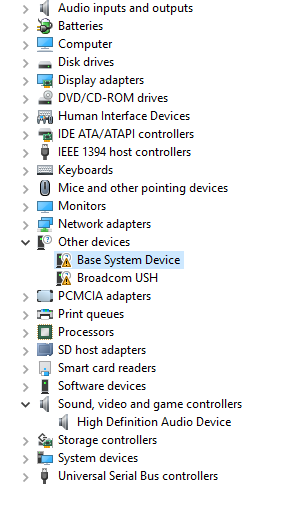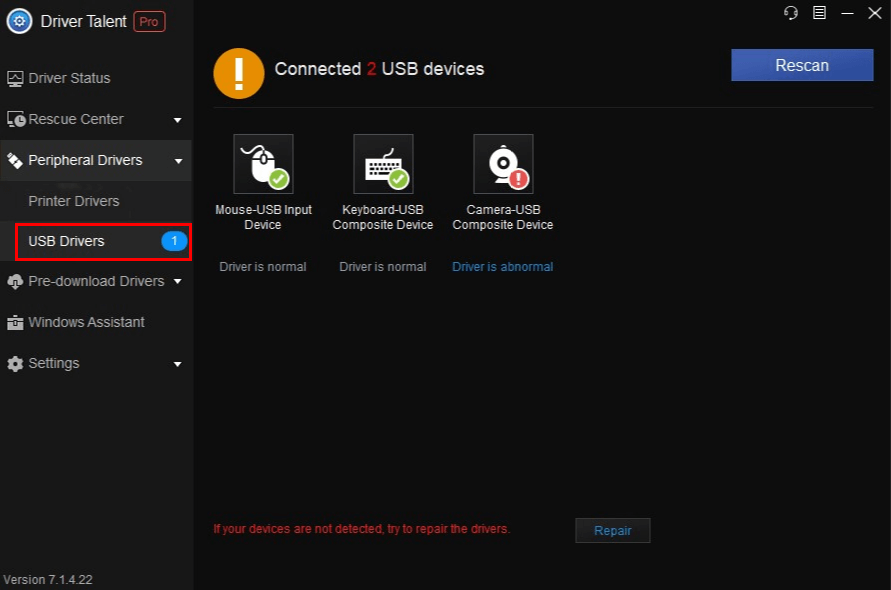Aug 27, 2019 Applies to: Windows 10 Before you begin Driver updates for Windows 10, along with many devices, such as network adapters, monitors, printers, and video cards, are automatically downloaded and installed through Windows Update. There wasn't an item as you suggested under 'disk drives' - but after rebooting the notebook with the SD Card inserted, I can now see an SD Host Adaptor ('SDA Standard Compliant SD Host Controller'). However, when I look at 'This PC' (I am on Windows 10) via File Explorer, I still cannot see anything that looks like an SD drive listed. I meant to say Windows 10 in the 3rd paragraph above (I updated my machine from Win 7 to 10 which caused this issue). Update: I found another driver for the O2 Micro OZ776 that was version 2.1.4.240 (I had ver 2.1.4.238) so I installed that and the card reader still doesn't work. Nov 14, 2017 There wasn't an item as you suggested under 'disk drives' - but after rebooting the notebook with the SD Card inserted, I can now see an SD Host Adaptor ('SDA Standard Compliant SD Host Controller'). However, when I look at 'This PC' (I am on Windows 10) via File Explorer, I still cannot see anything that looks like an SD drive listed.
- Sd Host Adapter Driver Windows 10 Download
- Sd Host Adapter Driver Windows 10 Pro
- Sd Host Adapter Driver Windows 10 32-bit
- Card Reader Adapter Download
| Description | Type | OS | Version | Date |
|---|---|---|---|---|
| Intel® SSD Data Center Tool (Intel® SSD DCT) The Intel® SSD Data Center Tool (Intel® SSD DCT) 3.0.27 is a management and firmware update tool for Intel® SSD Data Center Family products using SATA and PCIe* NVMe* drivers. | Software | Windows 10, 32-bit* Windows 10, 64-bit* Windows 8.1, 32-bit* 25 more | 3.0.27 Latest | 12/2/2020 |
| Intel® Memory and Storage Tool CLI (Command-Line Interface) The Intel® Memory and Storage Tool (Intel® MAS) is a drive management CLI tool for Intel® SSDs and Intel® Optane™ Memory devices, supported on Windows*, Linux*, and ESXi*. | Software | Windows 10, 32-bit* Windows 10, 64-bit* Windows 8.1, 32-bit* 21 more | 1.4 Latest | 11/23/2020 |
| Intel® Memory and Storage Tool (GUI) The Intel® Memory and Storage Tool (Intel® MAS) is a drive management tool for Intel® SSDs and Intel® Optane™ Memory devices, supported on Windows* (1.4). | Software | Windows 10, 32-bit* Windows 10, 64-bit* Windows 8.1, 32-bit* 5 more | 1.4 Latest | 11/23/2020 |
| Intel® Solid State Drive Toolbox Intel® Solid State Drive Toolbox version 3.5.15 is a drive management software that allows you to view SSD information, including firmware version, drive health, and more. | Software | Windows 10, 32-bit* Windows 10, 64-bit* Windows 8.1, 32-bit* 8 more | 3.5.15 Latest | 10/23/2020 |
| Datacenter NVMe* Microsoft Windows* Drivers for Intel® SSDs This download record installs version 5.1.0.1003 of the Intel® SSD Data Center Family for NVMe* drivers. | Driver | Windows 10* Windows 8.1* Windows 8* 4 more | 5.1.0.1003 Latest | 10/23/2020 |
| Client NVMe* Microsoft Windows* Drivers for Intel® SSDs Intel® NVMe* driver 5.1.0.1003 supports the Client Intel® SSD's based on PCIe* NVMe*. | Driver | Windows 10, 32-bit* Windows 10, 64-bit* Windows 8.1, 32-bit* 3 more | 5.1.0.1003 Latest | 10/23/2020 |
| Intel® RSTCLI Pro for Intel® Optane™ Memory The Intel® RST CLI Pro utility can be used to perform basic acceleration operations on Intel® Optane memory capable systems. | Software | Windows 10, 64-bit* | 18.0.1.1138 Latest | 10/15/2020 |
| Intel® Rapid Storage Technology Driver Installation Software with Intel® Optane™ Memory The Intel® Rapid Storage Technology (Intel® RST) Floppy Driver (18.0.1.1138) supports the configuration and enabling of system acceleration with Intel® Optane™ memory and maintenance of RAID 0/1/5/10. | Driver | Windows 10, 64-bit* Windows Server 2016* | 18.0.1.1138 Latest | 10/15/2020 |
| Intel® SSD Firmware Update Tool This download record installs version 3.0.10 of the Intel® SSD Firmware Update Tool. | Firmware | OS Independent | 3.0.10 Latest | 7/20/2020 |
| Intel® Rapid Storage Technology (Intel® RST) User Interface and Driver The Intel® Rapid Storage Technology (Intel® RST) Driver (16.8.3.1003) supports the configuration and enabling of system acceleration with Intel® Optane™ Memory and maintenance of RAID 0/1/5/10. | Driver | Windows 10, 64-bit* Windows Server 2016* | 16.8.3.1003 Latest | 7/2/2020 |
| Intel® Optane™ Memory User Interface and Driver for System Acceleration The Intel® Optane™ Memory UI is specifically designed and optimized to support system acceleration with Intel® Optane™ memory modules. (16.8.3.1003) | Driver | Windows 10, 64-bit* | 16.8.3.1003 Latest | 7/2/2019 |
| Intel® Volume Management Device (Intel® VMD) ESXi Tools These utilities are for Intel® Volume Management Device (Intel® VMD) driver version 1.4 and newer. | Software | VMware* | 1.4 and Newer Latest | 5/22/2019 |
| Intel® SSD Data Center Tool - Intel® SSD 910 Series The Intel® SSD Data Center Tool is drive management software for the Intel® SSD 910 Series. | Software | Windows 7* Windows Server 2008 R2* Windows Server 2003* 3 more | 1.1 Latest | 7/25/2013 |
Dolphin can store data to a virtual SD card named sd.raw. By default, it will be created with the size of 128MB.


The virtual SD card has important use for homebrew apps on Dolphin. Project M and Mario Kart Wii custom tracks are two good examples, as some homebrew apps can only work using files stored on the SD card of the real hardware for which they were designed.
- 1Creating a Virtual SD Card
- 2Editing a Virtual SD Card
- 4Usage

Creating a Virtual SD Card
It is recommend to create one with size at least 1GB for large homebrew apps, for example, Project M, and no more than 2GB for best compatibility as there are compatibility issues with some homebrew apps trying to run under an SDHC card on the real hardware.
Command Line and Executable Files
Download Virtual SD Card Maker, unzip it, and open the appropriate folder for your system (Linux / OS X / Windows). The tool is run with a command like:
- Open the Command Prompt or Terminal then (Note: Vista fails to support drag and drop, and will require manual input.):
- Drag and drop mksdcard file into the command window for the full directory pointing to mkscard.
- Type 2048M for 2GB, or if desired, an alternate size like 512M (512MB), 1024M (1GB), etc.
- Drag and drop an existing sd.raw file into the command window, or use a different directory/filename to create a new one.
- Assuming a default Global User Directory the virtual SD card should be placed at:
- Linux: ~/.dolphin-emu/Wii/sd.raw OR ~/.local/share/dolphin-emu/Wii/sd.raw
- OS X: ~/Library/Application Support/Dolphin/Wii/sd.raw
- Windows: '%userprofile%DocumentsDolphin EmulatorWiisd.raw' (quotation marks are necessary when copying it to Command Prompt)
Alternatively, a non-Mediafire download link can be found by visiting https://developer.android.com/studio/#command-tools and downloading the OS-specific zip there (mksdcard is part of the Android SDK)
Manual macOS Command Line Creation
This example creates a 2048 megabyte (2GB) SD card formatted as FAT32:
Manual Linux Command Line Creation
If the above tool does not work, one can manually create a FAT32 partition image in Linux provided dosfstools is installed.First, pull up a terminal, and then chdir into the Wii folder, which under certain configurations may be located at ~/.local/share/dolphin-emu/Wii instead.
Then, we must create our raw disk image. This example create a 2048 megabyte (2GB) SD card, but one can replace the 2048 with an alternate number of megabytes.
Finally, we format our image to FAT32.
Editing a Virtual SD Card
Linux
The virtual SD card can be edited by mounting it to a virtual disk. First create a directory:
Then mount sd.raw to it:
When you are done, simply unmount it like this:
macOS
In Terminal window, type the following to mount the virtual SD card:
The virtual SD card can then be ejected through Finder when done being edited.
If you get an error (hdiutil: attach failed - no mountable file systems), you can use these commands instead:
Windows
The Windows users must use a third party software that can mount the virtual SD card. Speaking of which... ImDisk Virtual Disk Driver
WinImage is unreliable, because oddly enough, it will cause desync and few other unforeseeable problems. ImDisk will be fine.
Quick guide for mounting and editing the virtual SD card with the ImDisk Virtual Disk Driver:
- Right-click on sd.raw file then click 'Mount as ImDisk Virtual Disk' from the context menu.
- Check box Removable media then hit 'OK'. The predefined drive letter and everything else will do just fine.
- The virtual SD card will now appear as 'Removable Disk' in which the native Explorer window can read and write in there.
- When done editing the virtual SD card, simply unmount it by right-click on the 'Removable Disk' then click 'Unmount ImDisk Virtual Disk' from the context menu.
- The virtual SD card must be dismounted before using with Dolphin.
Dolphin Setting
Go to Options > Configure... > Wii > and enable Insert SD Card.

Usage
With Homebrew App
The external files used for the homebrew app must be stored within sd.raw and the homebrew app itself (boot.elf or boot.dol) must exist outside of it for Dolphin to load. Project M, for example, will load from SD root projectm and Dolphin will need to launch Project M through appsprojectmboot.elf, NOT in the virtual SD card. For convenience's sake, it is ideal to have same copies paralleled between inside and outside of the virtual SD card.
Though, it is possible to start homebrew app from virtual SD card through homebrew exploits for Wii.
The Wii game launcher app will only work if a particular Wii game is set as the default ISO. Within the Dolphin game list, open context menu (right-click) on any Wii game and click Set as default ISO. Do this before loading a homebrew app with Dolphin.

Sd Host Adapter Driver Windows 10 Download
For Netplay
Sd Host Adapter Driver Windows 10 Pro
Netplay will eventually desync if anything reads the virtual SD card that is not cloned, regardless of the same size it was created, and identical file/folder structures within its root. To prevent that, sd.raw must be copied from host's computer to joiners' computers before starting netplay. If the virtual SD card was used offline or online with write block disabled, the MD5 checksum will change ('Date Accessed' of the files are what's different in virtual SD card), but will not cause desync. The SD card got to be coming from elsewhere or subjected to the files modified within to be 'different'.
Sd Host Adapter Driver Windows 10 32-bit
For the Wii game launcher app, users on both ends must have the same copies of homebrew app and the game in their game list first, then set the game as default ISO, as mentioned in previous section.
Card Reader Adapter Download
